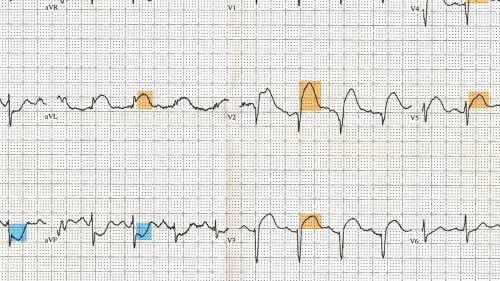Atrial flutter with 2:1 conduction is a frequently overlooked arrhythmia, often misinterpreted as sinus tachycardia due to its characteristic heart rate of approximately 150 bpm. This article provides ten practical tips to help clinicians accurately identify atrial flutter on an ECG, emphasizing the importance of distinguishing atrial activity from ventricular activity to reveal the subtle flutter waves that might otherwise be missed.
Fill out the form on this page to download a copy of the guide: 10 tips to identify atrial flutter.
When atrial flutter is conducted 2:1, the resulting ventricular rate is around 125-175 per minute (usually around 150). This is because the P waves (flutter waves) in atrial flutter occur at about 250-350 per minute (usually around 300).
At this rate, it can appear that there is a P wave in front of each QRS and a T wave after each QRS. This causes the misdiagnosis of sinus tachycardia or SVT. Remember SVT is a catch-all term that includes atrial tachycardia, AVRT and AVNRT.
The interpretive algorithms of ECG machines often get atrial flutter with 2:1 conduction wrong, just like people do.
Most ECG students are shown examples of atrial flutter that have 3:1, 4:1 or even 5:1 conduction, which exposes many flutter waves in a row, making them easy to recognize.
What is atrial flutter?
Atrial flutter is a re-entrant tachycardia that occurs in the atria. It can happen suddenly and is sometimes associated with periods of atrial fibrillation. The AV node is bombarded by a regular atrial rhythm of around 300 per minute. New-onset atrial flutter is most often conducted 2:1, because that is a comfortable rate (around 150 per minute) for the AV node to conduct.
When we see slower ventricular rates and conduction ratios of 3:1 or more, it is usually due to medications or other causes of enhanced refractoriness of the AV node. Atrial flutter can lead to fast rates at 2:1 conduction and VERY fast rates at 1:1 conduction.
In patients with accessory pathways that bypass the slow conduction of the AV node, like Wolff-Parkinson-White Syndrome, 1:1 conduction of atrial flutter or atrial fib can be life-threatening. As cardiac output is decreased and cardiac workload increased, ventricular fibrillation can result.
10 tips to avoid missing atrial flutter with 2:1 conduction
You won’t find atrial flutter it if you aren’t looking for it. Here are 10 tips to avoid missing atrial flutter.
1. Suspect any tachycardia
Any rhythm around 150 bpm should be suspected of being atrial flutter with 2:1 conduction. Remember that sinus rhythms tend to fluctuate slightly. For example, if your patient talks or moves around in bed, the rate may go up slightly. Re-entrant tachycardias hit a fast rate suddenly and maintain that rate until they end suddenly.
2. You see no obvious reason for sinus tachycardia
Consider atrial flutter if the patient has no obvious reason for sinus tachycardia. Most people with sinus tach, especially over 130 bpm, will usually have a readily-apparent reason for the tachycardia, like fever, fear, pain, anxiety, exertion, drugs, hypovolemia or hypoxia.
3. Be systematic in your approach to ECGs
Get your first impression, then think of alternate diagnoses and apply rhythm interpretation criteria. By evaluating the P waves, QRS complexes, intervals and rate, you may discover that your first impression was wrong.
4. Use more than one lead
For rhythm interpretation, the more leads the better. A 12-lead ECG can help immensely in seeing the flutter waves, because some leads are better for viewing atrial activity than others. In some leads, atrial flutter will not have a sawtooth pattern. You might consider using a Lewis lead, which enhances detection of atrial activity.
5. Watch a longer rhythm strip
Sometimes, 2:1 atrial flutter will momentarily conduct as 3:1 or more and the flutter waves will be apparent.
6. Pay attention to rhythm when treating SVT
Sometimes, atrial flutter will be mistaken for atrial tach, one of the SVT catch all rhythms, and treated with adenosine. This can cause a momentary slowing of the ventricular complexes, uncovering the flutter waves. While this is not recommended as a diagnostic procedure, it sometimes becomes one.
7. Consider atrial flutter even with wide QRS complexes
Atrial flutter can produce a wide-complex tachycardia, especially in the setting of hyperkalemia. Look carefully for the flutter waves.
8. Use the Bix Rule
This interpretation rule named after Harold Bix, a Viennese cardiologist and colleague of Dr. Henry Marriott, states that if a P wave appears halfway between two QRS complexes, there is likely a P wave hidden in the QRS complexes.
9. Rule out atrial fib
Atrial flutter has “F” waves, which are very regular and all alike in each lead. Atrial fibrillation has “f” waves, which may look like flutter waves at times, but are irregular and not all alike. In addition, the QRS rhythm will be irregularly irregular in atrial fibrillation.
10. Practice rhythm interpretation
Now that you are more aware of atrial flutter with 2:1 conduction, the best way to get good at recognizing it is regular practice. Look at as many strips of confirmed 2:1 conduction as you can and your eye will become trained to see it. You will learn to see the rhythm strip as separate atrial activity and ventricular activity portions and the hidden flutter waves will stand out for you.
With these tips and practice, you will be much less likely to mistake atrial flutter with 2:1 conduction for another tachycardia.
References
- Burns, E. (2012). Life In The Fast Lane. Retrieved from lifeinthefastlane.com: http://lifeinthefastlane.com/ecg-library/atrial-flutter/
- Dawn Altman, R. E.-P., & Kenneth Grauer, M. (2013, January 19). ECG Guru. Retrieved from ecgguru.com: http://ecgguru.com/ecg/atrial-flutter
- Vince DiGiulio, E.-C. (2011, December 22). Medial Approach. Retrieved from medialapproach.com: http://www.medialapproach.com/hidden-atrial-flutter/
- Watford, C. (2011, February 28). My Variables Only Have 6 Letters. Retrieved from sixlettervariable.blogspot.com: http://sixlettervariable.blogspot.com/2011/02/highlighting-atrial-activity-on-ecg-s5.html?m=1
This article was originally posted Nov. 15, 2016. It has been updated to include additional resources and a video.
EMS1 is using generative AI to create some content that is edited and fact-checked by our editors.
Fill out the form on this page to download a copy of the guide: 10 tips to identify atrial flutter.


























